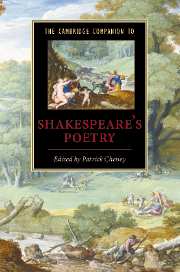Book contents
- Frontmatter
- Introduction: Shakespeare’s poetry in the twenty-first century
- 1 Shakespeare and the development of English poetry
- 2 Rhetoric, style, and poetic form
- 3 Print and manuscript
- 4 Venus and Adonis
- 5 The Rape of Lucrece
- 6 The Passionate Pilgrim and ‘The Phoenix and Turtle’
- 7 The Sonnets
- 8 A Lover’s Complaint
- 9 Poetry, politics, and religion
- 10 Love, beauty, and sexuality
- 11 Shakespeare and classicism
- 12 Poetry in Shakespeare’s plays
- 13 Poetry and performance
- 14 Reception and influence
- Reference works on Shakespeare’s poetry
- Index
Introduction: Shakespeare’s poetry in the twenty-first century
Published online by Cambridge University Press: 28 May 2007
- Frontmatter
- Introduction: Shakespeare’s poetry in the twenty-first century
- 1 Shakespeare and the development of English poetry
- 2 Rhetoric, style, and poetic form
- 3 Print and manuscript
- 4 Venus and Adonis
- 5 The Rape of Lucrece
- 6 The Passionate Pilgrim and ‘The Phoenix and Turtle’
- 7 The Sonnets
- 8 A Lover’s Complaint
- 9 Poetry, politics, and religion
- 10 Love, beauty, and sexuality
- 11 Shakespeare and classicism
- 12 Poetry in Shakespeare’s plays
- 13 Poetry and performance
- 14 Reception and influence
- Reference works on Shakespeare’s poetry
- Index
Summary
. . . we already know what poetry is. No problem there. It's poesis - a making, a made thing. If we accept Aristotle's definition, it's specifically a thing made out of speech and rhythm. We might press the matter further and agree with the Russian formalists that it's a thing made out of speech and rhythm that calls attention to its making and its made-ness.
Bruce R. Smith, 'Introduction', PMLA, 'Special Topic: On Poetry'Shakespeare . . . wrote the best poetry . . . in English, or perhaps in any Western language.
Harold Bloom, Shakespeare: The Invention of the HumanPoetry in the Shakespeare canon
The 'poetry' of William Shakespeare (1564-1616) constitutes one of the supreme achievements of world art. Readers may know this poetry most intimately from his drama, where it is on display across a dramatic canon of nearly forty plays, in the genres of comedy, history, tragedy, and romance, from early in his professional career (around 1590) to late (around 1614). Indeed, poetry makes up the large percentage of Shakespeare's theatrical writing (75 per cent), most of it in the blank verse (66 per cent) that he and his contemporary Christopher Marlowe helped turn into the gold standard of English verse. But the plays also include a good deal of rhymed verse (about 9 per cent), such as the sonnet prologue to Romeo and Juliet, as well as a large body of in-set lyrics (both songs and poems) in a wide range of metres and forms (over 130 pieces, with over 100 original compositions). Among the lyrics in the plays, we find some stunning poetry, from the concluding songs of 'Spring' and 'Winter' in Love's Labour's Lost (Riverside, 5.2.891) through the songs of Ariel in The Tempest: 'Those are pearls that were his eyes' (1.2.399). These lyrics include professional singer Amiens’ ‘Under the greenwood tree’ in As You Like It (2.5.1), the clown Feste’s ‘When that I was and a little tine boy’ (5.1.389) concluding Twelfth Night, and the lost princes of Britain’s ‘Fear no more the heat o’th’ sun’ in Cymbeline (4.2.258).
- Type
- Chapter
- Information
- The Cambridge Companion to Shakespeare's Poetry , pp. 1 - 13Publisher: Cambridge University PressPrint publication year: 2007
- 1
- Cited by



